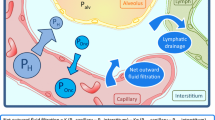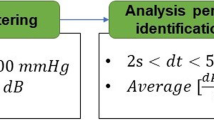Abstract
Clinical quantitation of water accumulation in the lungs is imprecise. The technique of measuring extravascular lung water (EVLW) with double indicator dilution utilizing cold indocyanine green dye has become practical with the addition of a microprocessor. The technique, insertion of a special thermistor tipped arterial catheter and potential problems are described. Our studies with resuscitation of 27 patients in shock indicate little increase in EVLW at 24 hours. On the other hand 19 patients with Adult Respiratory Distress Syndrome (ARDS) had marked increases in EVLW from normal of 5–8 ml/kg to 10.7 to 14.4 ml/kg. No further increases in EVLW were observed in eight ARDS patients requiring fluid resuscitation for associated hypovolemia and hypoperfusion. We feel that measurement of EVLW in critically ill patients offers an opportunity to study the pathophysiology of pulmonary failure.
Similar content being viewed by others
References
Beckett RC, Gray BA: Effect of atelectasis and embolization on extravascular thermal volume of the lung. J Appl Physiol 53: 1614, 1982.
Lewis FR, Elings VI: Microprocessor determination of lung water using thermal-green dye double indicator dilution. Surg Forum 29: 182, 1978.
Lewis FR, Elings VI, Strum JA: Bedside measurement of lung water. Journal of Surgical Research 27: 250–261, 1979.
Lindsay WG, Humphrey EW: Measurement of pulmonary extravascular water. Surgery 71: 650–660, 1972.
Lung Water System Educational Manual, Edwards Laboratories, Santa Anna, CA. 1980.
Mackerse RC, Christensen JM, Pitts LH, Lewis FR: Pulmonary extravascular fluid accumulation following intracranial injury. Journal of Trauma 23: 968–973, 1983.
Maki DG, Weise CD, Sarafin NW: A semiquantitative culture method for intravenous catheter related infection. N Engl J Med 296: 1305–1307, 1977.
Noble WH, Kay JC, Maret KH, Caskanette G: Reappraisal of extravascular lung thermal volume as a measure of pulmonary edema. American Physiological Society, 1977, pp. 120–129.
Puri VK, Groves M, Raheja R: Sequential lung water changes in adult respiratory distress syndrome. (Abst) Am Rev Resp Dis May, 1985, p A138.
Puri VK, Howard M, Raheja R: Beside measurement of Extravascular Lung Water in the Critically Ill. (Abst) Clinical Research 31: 259, 1983.
Sibbald WJ, Cunningham DR, Chin DN: Non-cardiac or cardiac pulmonary edema? Chest 84: 4: 452–460, October, 1983.
Sibbald WJ, Short AK, Washawski FJ: Thermal measurement of Extravascular Lung Water in Critically Ill Patients. Chest 87: 585, 1985.
Staub N, Hogg JC: Clinical use of lung water measurements. Report of a workshop Chest 90: 588, 1986.
Tranbaugh RF, Lewis FR: Mechanisms and etiologic factors of pulmonary edema. Surgery GYN & OB 158: 193–206, 1984.
Lava JS, Rice CL, Levine HA et al.: Extravascular lung water as a function of the magnitude of pulmonary artery pressure in the septic pig. J Surg Res 33: 440–448 1982.
Author information
Authors and Affiliations
Rights and permissions
About this article
Cite this article
Groves, M., Puri, V.K. & Raheja, R. Extravascular lung water measurement by double indicator dilution in shock and respiratory failure. J Clin Monit Comput 4, 223–229 (1987). https://doi.org/10.1007/BF02915862
Issue Date:
DOI: https://doi.org/10.1007/BF02915862




